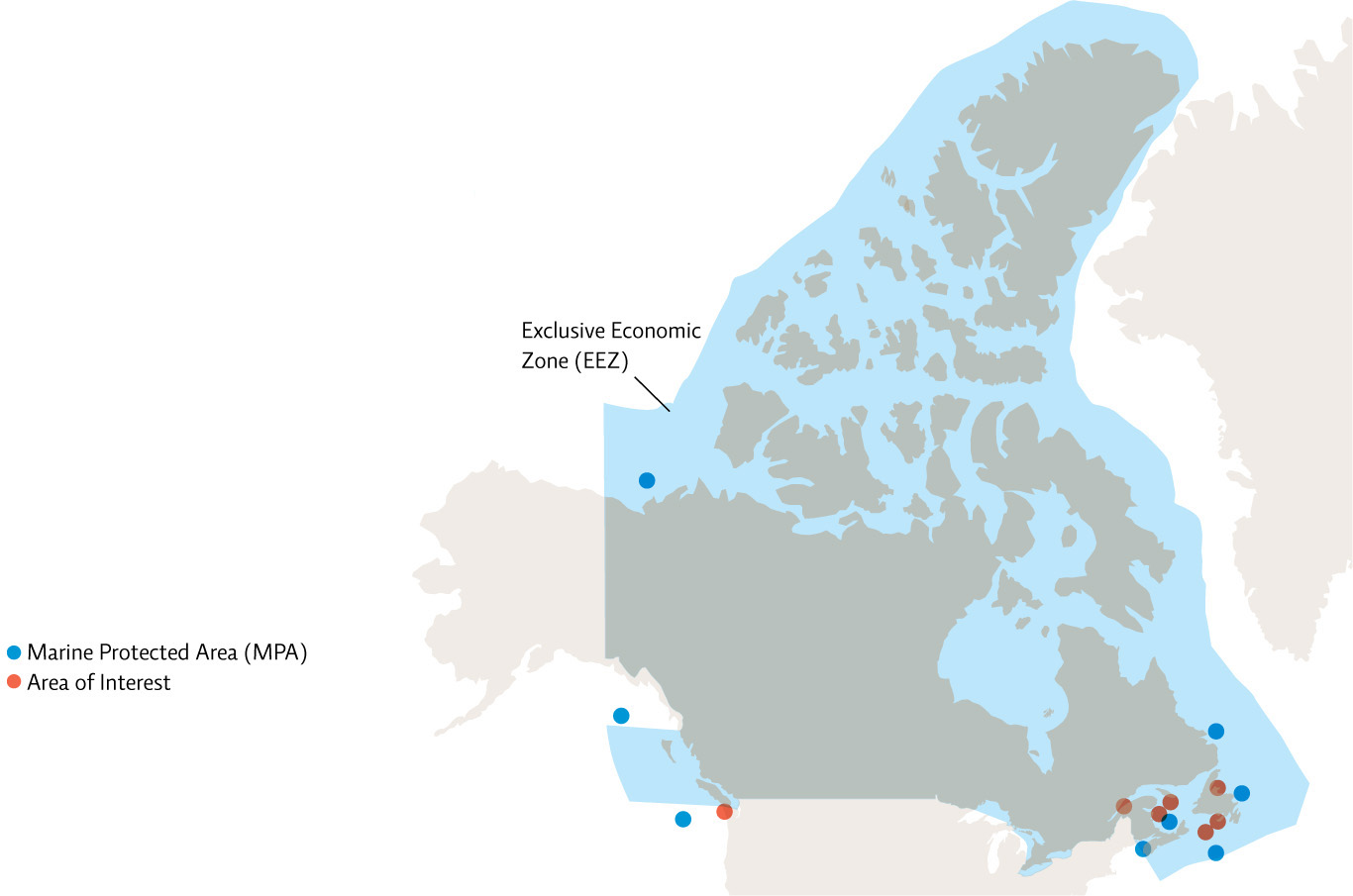14.3 Laws exist to protect and manage fisheries.
For most of human history, it seemed impossible that we could ever use up the resources in something as vast as the ocean, but in recent decades, that thinking has begun to change. As human populations swell and fish populations plummet, scientists and lawmakers around the world are struggling to reverse the damage that’s already been done, and to protect our fisheries from further decline. They started by enacting legislation.
For centuries, most nations defined their territorial waters, or exclusive fishing zones, as extending 12 nautical miles (22 kilometres) off their coastlines. In the 1960s, it became clear that such zones were inadequate. Wide-ranging industrial ships—floating factories, replete with freezing and processing technology—had long freed fishers from the shackles of time and distance. They could now pursue any fishery they liked, no matter how far from their home country. With no rule of law to constrain them, they could stay as long as they pleased and take as much as they wanted. No fishery stood a chance against a global army of such ships. One response to this problem was the creation of larger exclusive economic zones (EEZs) that extend 200 nautical miles (370 kilometres) from the coastline of any nation, where that nation has exclusive rights over marine resources, including fish.
249
For a long time, most countries, including Canada, simply chased other nations out of their fishing territories, while still allowing their own fishers to take as much as they pleased. But with fisheries around the world at or near collapse, fisheries managers started cracking down. In the Canadian cod fisheries, for example, officials set strict limits on the amount of ground (bottom-dwelling) fish of any species that any vessel may take. Once the vessel reached its predetermined limit, it was required to stop fishing for the season.
250
251
Fisheries managers worldwide have also created more than 1500 marine protected areas (MPAs)—discrete regions of ocean that are legally protected from various forms of human exploitation. As the country with the longest coastline in the world (including 3 oceans and the 5 Great Lakes), Canada plans to develop a national network of over 800 MPAs, in a comprehensive approach to protecting marine resources. The Oceans Act is federal legislation that allows Fisheries and Oceans Canada to designate existing “areas of interest” as official MPAs. Many of these MPAs protect only specific elements within the area—certain species of fish, a discrete portion of the habitat (like a spawning ground), or a cultural artifact (like a sunken ship). Some of them—albeit only a small number—are fully protected marine reserves, “no-take” zones, where no fishing can occur and human activities are prohibited. Sea life does recover in and near no-take MPAs, so there is reason to be encouraged. [infographic 14.5]

The primary law governing marine fisheries management in Canadian waters is the Fisheries Act, first passed in 1867 (the same year the nation was formed). It was tweaked over the years and modernized in 1985. It regulates fishing, as well as the harvesting of marine plant life, and protects marine habitats by prohibiting destruction and pollution. The main goal of the act is to maintain a sustainable fishery for commercial, recreational, and Aboriginal uses.
But managing oceans, which make up 70% of the planet, is no small feat, and despite these efforts, fisheries have continued to dwindle. Part of the problem is the enormous amount of illegal, unreported, and unregulated fishing—between $4 and $9 billion worth every year.
252
In some fisheries, 30% or more of the annual catch is harvested with illegal gear, in prohibited areas, or at prohibited times.
Here’s another problem: so far, fisheries management has been based on incomplete science. For example, The State of the World’s Fisheries and Agriculture, a biannual report issued by the Food and Agriculture Organization (FAO), estimates fish stocks and makes recommendations for maintaining fisheries sustainably. But it bases its conclusions almost exclusively on population studies—research that uses characteristics like a species’ rate of reproduction and time to reach adulthood to determine how many fish can be taken without jeopardizing the fishery. Successful management requires more than that. To maintain individual species at sustainable levels, fisheries managers need to consider the entire ecosystem in which the species resides—not just the abundance of the target fish, but also that of the fish they feed on, the overall health of their spawning grounds, and a host of other factors. Indeed, it was partly a lack of understanding of these additional factors—such as increases in technological efficiency—that caused the Canadian government to dramatically overestimate the total allowable catch (TAC) for cod in the 1980s, which let fishers catch more than the stock could stand to lose. Political and economic pressures to maintain the cod fishing industry in poor regions also led the government to set limits higher than even their own scientists recommended.
The Marine Stewardship Council, an international, nonprofit organization that certifies fish food products as sustainable, defines a sustainable fishery as one that ensures that fish stocks are maintained at healthy levels, that the ecosystem is fully functional, that fishing activity does not threaten biological diversity, and that the fishery is managed effectively. The Council currently recognizes 104 certified fisheries, and another 143 are undergoing assessment for certification.
Of course, no management strategy can reconcile limited supplies with rising demand, which is why, even as net pen operations like the ones in Frenchman Bay, Maine, proliferate around the world, more and more scientists are saying that the real solution to our fish problem won’t be found in the ocean at all.